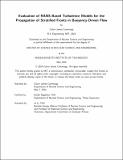Evaluation of RANS-Based Turbulence Models for the Propagation of Stratified Fronts in Buoyancy-Driven Flow
Author(s)
Cummings, Calvin James
DownloadThesis PDF (13.98Mb)
Advisor
Baglietto, Emilio
Terms of use
Metadata
Show full item recordAbstract
Computational fluid dynamics (CFD) is a powerful tool in the design of next-generation nuclear reactors. These reactors are designed to be inherently safe, utilizing physical phenomena such as buoyancy and natural convection to cool the core in the event forced circulation fails. However, the widely implemented Reynolds-averaged Navier-Stokes (RANS) approach to turbulence modeling has previously shown limitations in its ability to adequately predict buoyancy-driven f lows, including thermally stratified flow. Inaccuracies in these cases are often attributed to the Reynolds analogy, a simplification of the turbulent heat flux. To evaluate the validity of the Reynolds analogy under thermal stratification, the HiRJet experiment was constructed at the University of Michigan. HiRJet induces stratification and measures the propagation of stratified fronts over time. This work aims to drive conclusions on the validity of RANS-based models and the Reynolds analogy for stratified flows and develop best practices for CFD applications under these conditions. This is achieved by rigorously assessing the performance of several common turbulence models through comparison to high resolution results from HiRJet and direct numerical simulation (DNS). Sources of inaccuracy were identified through evaluation of separate components such as treatment of turbulence production due to buoyancy and modeling of anisotropic turblence. The STRUCT-ϵ model was adopted to evaluate the impact of resolving turbulent structures on predictions. The buoyancy production flux model (BPFM) was implemented to explore the advantages and challenges of more completely modeling the buoyancy production term in RANS-based models. Most importantly, this work shows that RANS-based turbulence models accurately reproduce experimental and DNS results, demonstrating that, despite widespread skepticism, the Reynolds analogy is not the primary source of error in modeling stratified flows.
Date issued
2024-05Department
Massachusetts Institute of Technology. Department of Nuclear Science and EngineeringPublisher
Massachusetts Institute of Technology